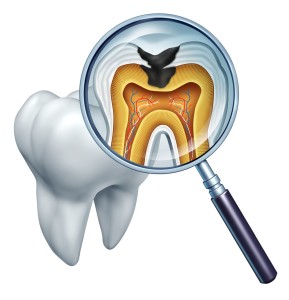Root Canal Treatment is Safe & Effective
This information is provided by the American Association of Endodontists. Internet claims that root canal treatment causes cancer or other health problems are unfounded. Decades of research—and millions of successful treatments annually—prove that endodontic treatment is safe and effective. The following articles are great resources on the safety of root canal treatment from the American Association of Endodontists.
How Do Root Canals Work?
When the infected or inflamed pulp is removed and the canal is cleaned and shaped it is then filled and sealed. Endodontic treatment removes the infection and seales the root canals from further infection. A Root Canal can save your natural tooth from extraction while restoring aesthetics and function.
Why Do I Need A Root Canal?
Your doctor may reccommend a root canal, or you may find that pain or sensitivity continues after it had been previouslly filled. It is possible an endodontic treatment (root canal) may need to be performed. Continued pain may be signs that the pulpal or nerve tissue inside the tooth is irreversibly damaged.
The Treatment Process
Before the endodontic treatment process begins your Endodontist will examine and x-ray your tooth. When the endodontist decides that a root canal is the optimal treatment plan, he will then explain your specific procedure and treatment method before beginning the process.
To begin, the site will be preppred, the tooth and the area around the tooth will be numbed. Once your Endodontist has confirmed with you that the area is completely frozen he will begin by opening the crown of the tooth. The next step is to thoroughly clean and remove the injured pulp from the pulp chamber and shape the root canals for filling. The canals are filled with a biocompatible material and placed with an adhesive cement to ensure that they are completely sealed. The tooth is closed temporariliy with a temporary filing, which will be removed by your dentist before the restoration or crown is placed. This step is completed by your dentist to protect and restore the tooth to its natural function. After treatment it will be necessary to return to your dentist as soon as possible to have a new crown or other restoration placed to protect the tooth. Oshawa Endodontics recommends booking both appointments well in advance to ensure your treatment process is as smooth as possible
In some cases a tooth may lack sufficient structure to hold the restoration in place. If this is the case, your Endodontist may place a post inside the tooth for stability. Ask your Dentist or Endodontist about your specific treatment plan.
For a more detailed explenation of the endodontic treatment process you can visit the American Association of Endodontics here.
What is the cost of a Root Canal
The cost associated with a Root Canal procedure vary depending on a number of factors, inluding the severity of damage, the complexity of the problem and the tooth affected.
In most cases a Root Canal including the endodontic treatment and restoration of the natural tooth is a less expensive treatment option than the alternative of having the tooth extracted and replaced.
Most dental insurance policies provide some converage for endodontic treatment aswell. If you have any insurance or payment questions, feel free to call our office and speak to our receptionists or accounts department to discuss how we can help during this process.
Does The Root Canal Hurt?
Rather than cause pain, many endodontic procedures are performed to relieve pain caused by pulp inflammation or infection. As well, with modern techniques and anesthetics, most patients report that they are comfortable during the procedure. The tooth and surrounding treatment area will be completely numb during treatment so you won’t feel any pain. After treatment you may experience some post operative sensitivity, especially if their was pain or infection before the procedure. This sensitivity is completely manageable with a prescribed regimen of over-the-counter or prescription pain medication.
Pain should not continue more than a few days after treatment. If pain continues book an appointment with your endodontist as soon as possible.
Focal Infection Theory Fact Sheet
(Click Here to Download PDF)
Explains the history of focal infection and research showing that there is no valid, scientific evidence linking endodontically treated teeth and systemic disease.
Myths About Root Canals and Root Canal Pain
(Click Here to Download PDF)
This patient-focused information on the AAE website explains the safety and effectiveness of root canal treatment.
Tooth Saving Tips
(Click Here to Download PDF)
Another patient-focused resources explaining why saving a tooth should always be the first choice for the greatest health and cosmetic results.

